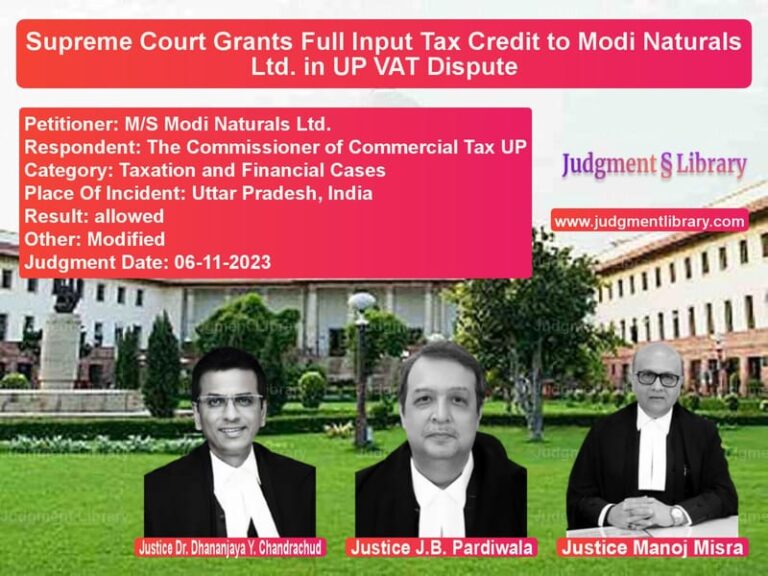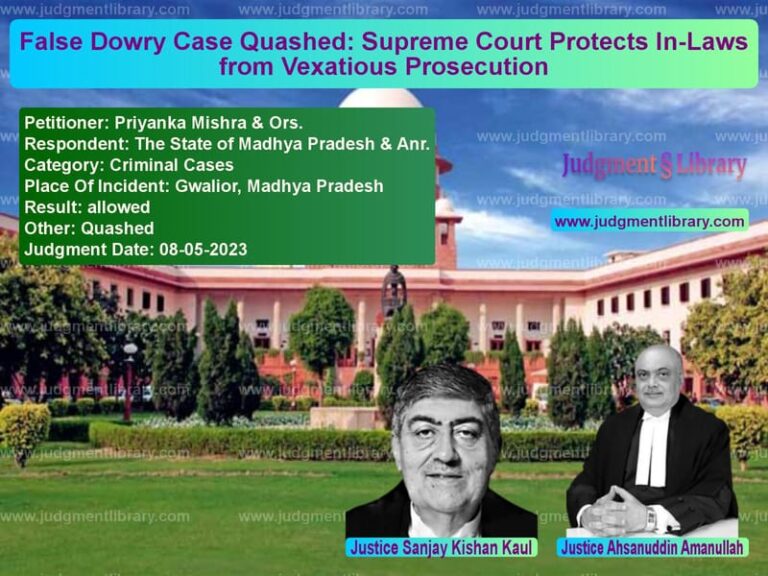CENVAT Credit Eligibility for Mobile Service Providers: Supreme Court Judgment Analysis
The Supreme Court of India has recently delivered a crucial judgment in the case of M/S Bharti Airtel Ltd. vs. The Commissioner of Central Excise, Pune, which addresses the eligibility of CENVAT credit for mobile service providers on mobile towers and prefabricated buildings (PFBs). This ruling clarifies a longstanding dispute on whether such infrastructure qualifies as ‘capital goods’ or ‘inputs’ under the CENVAT Credit Rules, 2004.
Background of the Case
Mobile service providers in India have long argued that telecom towers and PFBs are essential components of their service delivery and should be eligible for CENVAT credit. However, tax authorities have contended that these structures become immovable property upon installation and therefore do not qualify as capital goods.
In this case, Bharti Airtel, one of India’s largest telecom service providers, claimed CENVAT credit on excise duties paid on mobile towers and PFBs, arguing that they are directly linked to service provision. However, the Commissioner of Central Excise, Pune, denied this claim, stating that these components do not fit within the definition of ‘capital goods’ or ‘inputs’ under the rules.
Key Legal Issues
- Whether mobile towers and PFBs qualify as ‘capital goods’ under Rule 2(a)(A) of the CENVAT Credit Rules, 2004.
- Whether these structures can be considered ‘inputs’ under Rule 2(k), as they contribute to the output service of telecom providers.
- The distinction between movable and immovable property in the context of taxation and whether CENVAT credit can be claimed on items that eventually become immovable.
- Conflicting judgments by various High Courts regarding the eligibility of CENVAT credit on telecom infrastructure.
Supreme Court’s Observations
The Supreme Court conducted an in-depth examination of the definitions of ‘capital goods’ and ‘inputs’ under the CENVAT Rules and analyzed the marketability and functionality of telecom infrastructure. The key observations were as follows:
1. Functionality Test
The Court recognized that mobile towers and PFBs are essential for telecom services, working in conjunction with BTS and antennas. It stated:
“The fundamental test for determining CENVAT eligibility is whether the component is indispensable to the provision of the output service. In the case of mobile towers and PFBs, they are not mere facilitators but integral to the infrastructure.”
2. Movability vs. Immovability
Addressing the question of whether telecom towers and PFBs become immovable property upon installation, the Court observed:
“The test of movability is not absolute fixity but the ability to be dismantled and relocated. Since mobile towers and PFBs can be relocated and reinstalled, they do not become immovable property in the strict legal sense.”
3. Inclusion Under ‘Capital Goods’
The Court found that mobile towers and PFBs qualify as ‘accessories’ to BTS and antennas, making them eligible for CENVAT credit under Rule 2(a)(A)(iii).
4. Inclusion Under ‘Inputs’
The Court further ruled that these structures meet the definition of ‘inputs’ under Rule 2(k), as they directly contribute to providing telecom services.
Final Verdict
The Supreme Court ruled in favor of the petitioner, Bharti Airtel, and made the following declarations:
- Mobile towers and PFBs qualify for CENVAT credit as both ‘capital goods’ and ‘inputs’ under the CENVAT Credit Rules.
- Excise duties paid on these components are recoverable under Rule 3.
- The ruling of the Bombay High Court denying credit was overturned.
- The Delhi High Court’s judgment affirming CENVAT credit eligibility was upheld.
Implications of the Judgment
This ruling has far-reaching consequences for the taxation framework in India, particularly for the telecom industry. The key takeaways include:
- Reduced Tax Burden: Telecom service providers can now claim CENVAT credit on mobile towers and PFBs, lowering their effective tax liability.
- Precedent for Other Industries: The judgment sets a precedent for other industries that rely on large-scale infrastructure, clarifying what constitutes ‘capital goods’ and ‘inputs.’
- Increased Clarity in Tax Interpretation: The Supreme Court’s ruling resolves inconsistencies in High Court interpretations, ensuring uniform application of tax rules across jurisdictions.
- Reassessment of Previous Tax Claims: Telecom companies may reassess past tax filings to claim retrospective CENVAT credit benefits.
By recognizing mobile towers and prefabricated buildings as eligible for CENVAT credit, the Supreme Court has reinforced the principle that taxation must align with industrial realities. This ruling is expected to provide significant relief to telecom companies while ensuring compliance with the broader tax structure.
Petitioner Name: M/S Bharti Airtel Ltd..Respondent Name: The Commissioner of Central Excise, Pune.Judgment By: Justice B.V. Nagarathna, Justice Nongmeikapam Kotiswar Singh.Place Of Incident: Pune.Judgment Date: 19-11-2024.
Don’t miss out on the full details! Download the complete judgment in PDF format below and gain valuable insights instantly!
Download Judgment: ms-bharti-airtel-lt-vs-the-commissioner-of-supreme-court-of-india-judgment-dated-19-11-2024.pdf
Directly Download Judgment: Directly download this Judgment
See all petitions in Income Tax Disputes
See all petitions in GST Law
See all petitions in Tax Evasion Cases
See all petitions in Banking Regulations
See all petitions in Tax Refund Disputes
See all petitions in Judgment by B.V. Nagarathna
See all petitions in Judgment by N. Kotiswar Singh
See all petitions in allowed
See all petitions in supreme court of India judgments November 2024
See all petitions in 2024 judgments
See all posts in Taxation and Financial Cases Category
See all allowed petitions in Taxation and Financial Cases Category
See all Dismissed petitions in Taxation and Financial Cases Category
See all partially allowed petitions in Taxation and Financial Cases Category







